psychology chapter 7 lecture
1/53
There's no tags or description
Looks like no tags are added yet.
Name | Mastery | Learn | Test | Matching | Spaced |
|---|
No study sessions yet.
54 Terms
Forming Impressions of Others
Key Sources of Information
As we engage in person perception, “the process of forming impressions of others,” we rely on five key sources of information:
1. Appearance
2. Verbal behavior
3. Actions
4. Nonverbal messages
5. Situational cues
Forming Impressions of Others
Snap judgments vs. systematic judgments
Snap judgments about others “are those made quickly and based on only a few bits of information and preconceived notions.“
• They are “shortcuts” that rely on automatic processing, and are used when we are not motivated to form an accurate impression of another person
Forming Impressions of Others: systematic judgments
Systematic judgments require more controlled processing and tend to occur when forming impressions of others that can affect our happiness or welfare
Social Psych - Attributions
Attributions - judgements about the causes of our own and other people’s behaviour and outcomes.
Internal attributions - infer that people’s behaviour is caused by their characteristics.
External attributions - infer that aspects of the situation cause a behaviour.
Fundamental Attribution Error We underestimate the impact of
the situation and overestimate the role of personal factors when explaining people’s behaviour.
Fundamental Attribution Error Example - Jones & Harris, 1967
“Fidel Castro Debate” Study
Pro vs. Anti Castro
One group told position was chosen freely.
One group was told position was assigned.
Rate the debater’s attitude toward Castro.
Participants essentially disregarded the situational factor of it being assigned and still attributed Pro or Anti Castro attitudes
Attributions Self-serving bias
making relatively more personal attributions for successes and more situational attributions for failures.
Forming and Maintaining Impressions
We are constantly forming impressions of other people and vice versa.
Attributions play a key role in impression formation
Does a person’s behaviour say something about her or him, or is it caused by the situation?
What other factors impact how we form and maintain impressions?
Forming and Maintaining Impressions example
Person A: Intelligent Industrious Impulsive Critical Stubborn Envious
Person B: Envious Stubborn Critical Impulsive Industrious Intelligent
Forming and Maintaining Impressions Primacy Effect -
tendency to attach more importance to the initial information that we learn about a person.
New information can change our opinion, but it has to “work harder” to overcome the initial impression.
We tend to be more alert to info we receive first.
Initial information shapes subsequent information
Forming Impressions of Others Perceiver expectations
How we expect others to behave can influence our actual perceptions of them.
Confirmation bias – “the tendency to seek information that supports one’s beliefs while not pursuing disconfirming information.”
Social Psych - Attributions: Attributions
judgements about the causes of our own and other people’s behaviour and outcomes.
Social Psych - Attributions: Internal attributions
infer that people’s behaviour is caused by their characteristics.
Social Psych - Attributions: External attributions
infer that aspects of the situation cause a behaviour.
Fundamental Attribution Error
Someone is driving slow in front of you
“Moron”!!!
Someone is driving fast, passes you
“Maniac”!
What about when you are driving “slow” or “fast”?
Fundamental Attribution Error explanation
We underestimate the impact of the situation and overestimate the role of personal factors when explaining people’s behaviour.
Confirmation Bias
• Tendency to look for evidence that will confirm a conclusion
• Tendency not to look for evidence that could disconfirm beliefs
Reasoning The (Wason) card selection task:
• A four-card problem based on conditional reasoning
• Problem appears deceptively simple but participants often end up mistaken
• Need to choose cards that disconfirm the rule, but participants tend to choose cards that could confirm the rule
• Better performance for versions that are more realistic
Reasoning Propositional (Conditional) Reasoning: Wason Selection Task
You have been hired as a bouncer in a bar and you must enforce the following rule: "If a person is drinking beer, then he must be over 19 years old." The cards above have information about four people in the bar. One side of each card lists a person's age and the other side shows what he or she is drinking. Which card(s) do you need to turn over to be sure no one is breaking the law?
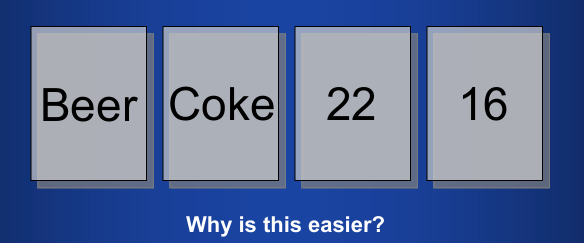
Reasoning Propositional (Conditional) Reasoning: Wason Selection Task: Memory Cueing Explanation
Certain contents of the problem cue, or call to mind, personal experiences that are relevant to the rule
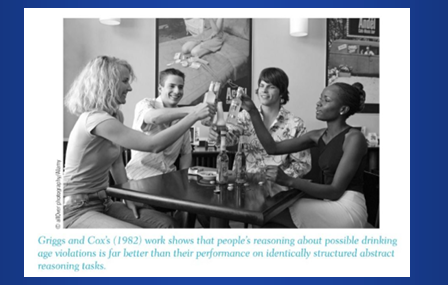
Reasoning The following triplet conforms to a particular rule. Determine what the rule is… but…
You may not ask direct questions about the rule
• You have to offer your offer examples of triplets, and for each one you give, you’ll be told whether it follows the rule
• You should not try to guess; you should announce a rule only when you are confident you know what it is.

Reasoning Inductive Reasoning: Wason 2 4 6 Task ( Wason , 1960, 1977)
Findings:
• Of the 29 original participants, only 6 discovered the correct rule without first making incorrect guesses, 13 others made one wrong guess, 9 reached two or more incorrect conclusions, and 1 reached no conclusion at all
• People appear to develop a general idea of the rule, then construct examples that follow the rule.
• What they fail to do is to test their rule by constructing a counterexample— a triplet that, if their rule is correct, won’t receive a yes answer from the experimenter.
• Confirmation bias - participants seem to be trying to confirm that their rule is true, rather than trying to test their rule
Forming Impressions of Others • Stereotypes
“widely held beliefs that people have certain characteristics because of their membership in a particular group."
• Some examples include ethnicity, race, gender, religion • Also based on physical appearance (e.g., what is-beautiful-is-good stereotype)
• For example, attractive people are perceived more favorably than justified. Aka The Halo Effect.
Forming Impressions of Others: Cognitive distortions
Social categorizations – cognitive “shortcuts” in which we categorize people.
• People perceive similar individuals to be members of their ingroup (us) and dissimilar people to be members of the outgroup (them).
The Problem of Prejudice: Threats to social identity
when the collective self-esteem of a group is threatened, two response may occur:
• Ingroup favoritism
• Outgroup denigration
The Problem of Prejudice: Prejudice
“a negative attitude toward members of a group”
The Problem of Prejudice: Discrimination
“involves behaving differently, usually unfairly, toward the members of a group”
The Problem of Prejudice
• Prejudice and discrimination often go together, but this is not always the case.
Prejudices and stereotypes can be triggered without conscious awareness and can have consequences for behavior.
Prejudice & The Bystander Effect (remember diffusion of responsibility)
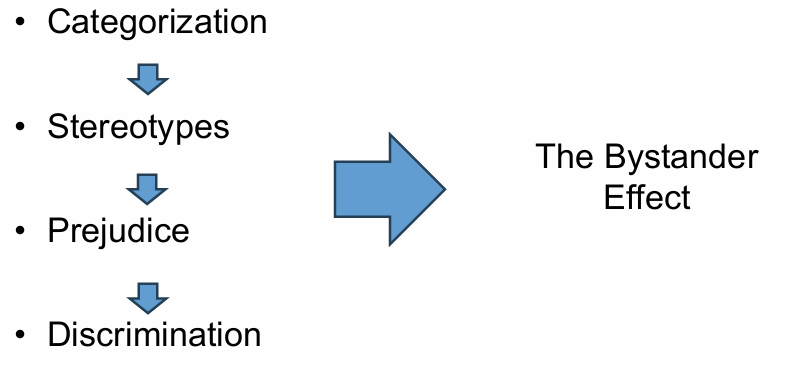
The Problem of Prejudice: Reducing prejudice
• Cognitive strategies – make an effort to override stereotypes by using controlled processing.
Intergroup contact
• Superordinate goals – “goals that require two or more groups to work together to achieve mutual ends” can reduce intergroup hostility.
Conformity
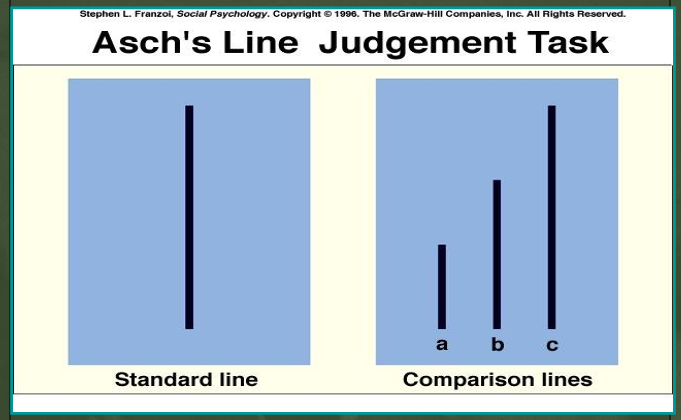
The Power of Social Pressure
Solomon Asch’s (1955) classic study demonstrated that people conformed easily to wrong answers given by others in a mock perception test.
• Conformity also increased, to a point, as group size increased, peaking at seven members.
Influences
• Group Size
– Conformity increases as group size increases, up to a point
• Presence of a dissenter
– At least one reduces conformity
Why do we conform?
Informational social influence
We follow others behaviours because we believe they have accurate knowledge and what they are doing is “right”.
Normative social influence
We follow others to obtain rewards that come from acceptance or also avoiding rejection.
The Power of Social Pressure: Conformity versus compliance
• Conformity – “occurs when people yield to real or imagined social pressure.”
• Compliance – “occurs when people yield to social pressure in their public behavior, even though their private beliefs have not changed."
The Power of Social Pressure: Pressure from authority figures
Obedience – “is a form of compliance that occurs when people follow direct commands, usually from someone in a position of authority."
• The dynamics of obedience
Stanley Milgram’s classic study (1963) demonstrated that people’s tendency to obey is strong, even if they are asked to harm another person.
Milgram’s Obedience Study
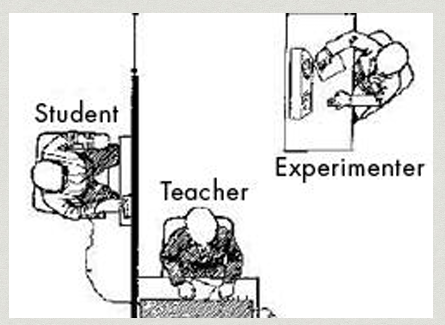
Milgram’s Shock Generator

Obedience Milgram’s experiment Pt 2
Two volunteers for the study. One is assigned as the “teacher”, the other is assigned as the “learner”.
Deliver a shock when a mistake was made
Milgram asked psychologists, students, etc, to predict level of obedience - 1%
Milgram’s Obedience Experiments
Milgram asked psychologists, students, etc, to predict level of obedience - 1%
In actual fact 65% obeyed to highest level of shock value.
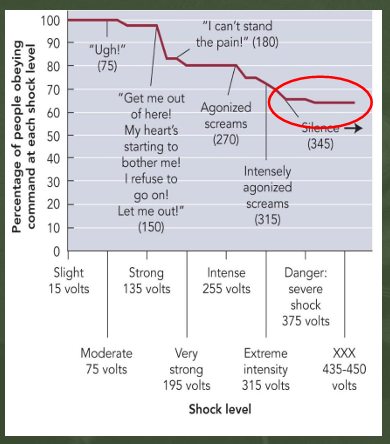
AUTHORITY FIGURE’S RESPONSES…
•What did the “Experimenter” say that was so powerful?
Prod 1: please continue.
Prod 2: the experiment requires you to continue.
Prod 3: It is absolutely essential that you continue.
Prod 4: you have no other choice but to continue.
Milgrams' Agency Theory
Milgram (1974) explained the behavior of his participants by suggesting that people actions and two states of behavior when they are in a social situation:
The autonomous state– people direct their own actions, and they take responsibility for the results of those actions.
The agentic state– people allow others to direct their actions and then pass off the responsibility for the consequences to the person giving the orders. In other words, they act as agents for another person’s will
Milgram’s Results
• What factors could contribute to change the results?
What could be done that would diminish obedience in this situation?
The Milgram Study
Would these changes in the experimental design influence the results?
- Change of building? (office building instead of University)- Teacher & Learner in the same room?
- Teacher has to force Learner’s hand onto a shock plate?
- Experimenter leaves and “ordinary” person gives orders?
- Experimenter leaves and gives order over a phone?
- Teacher witnesses 2 other Teachers rebel?
- Teacher gets to chose what level of shock to give?
Variations of Original Study
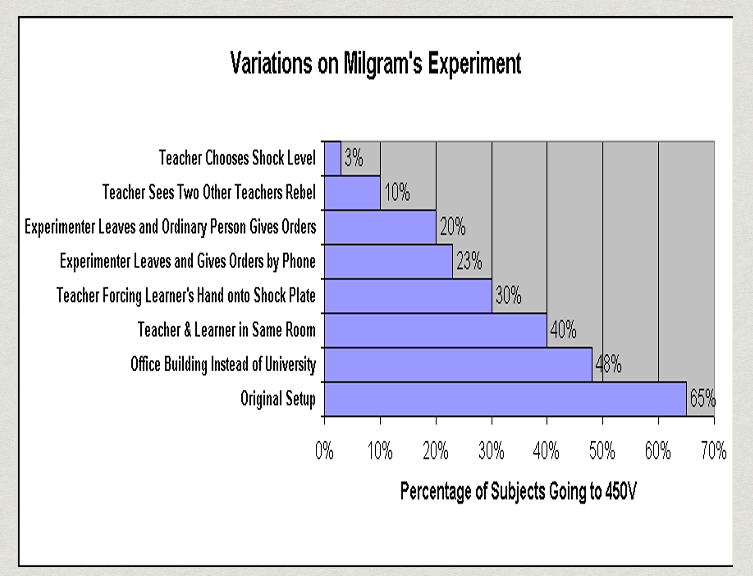
Factors and Variations from Milgram’s experiment
Uniform
In the original baseline study – the experimenter wore a grey lab coat as a symbol of his authority (a kind of uniform). Milgram carried out a variation in which the experimenter was called away because of a phone call right at the start of the procedure. The role of the experimenter was then taken over by an ‘ordinary member of the public’ (a confederate) in everyday clothes rather than a lab coat.
The obedience level dropped to 20%.
Milgram Study
If all of those scenarios reduce obedience to some degree, what is the underlying factor(s)?
What keeps someone in an autonomous state rather than an agentic state?
1. Removal of responsibility
2. Belief in the Authority figure
Factors and Variations: Two Teacher Condition
When participants could instruct an assistant (confederate) to press the switches, 92.5% shocked to the maximum 450 volts. When there is less personal responsibility obedience increases. This relates to Milgram's Agency Theory
Compliance Strategies: Many of these techniques are used by telemarketers and salespeople
1. Norm of Reciprocity - expectation that when others treat us well, we should respond in kind. Example - Hari Krishna’s “Flower Power” technique.
2. Door-in-the-Face technique - Persuader makes a large request, expecting you to reject it and then presents a smaller request.
Compliance Techniques (Cont.)
3. Foot-in-the-door technique - persuader gets you to comply with a small request first and later presents a larger request.
• Example - Gueguin, 2002. Email asking you to complete a 20min survey about your dietary habits. 44% say yes.
• But if first asked for a simple piece of advice, takes 1-min. And then later asked to do the survey.
• 76% agreed.
visual of compliance techniques
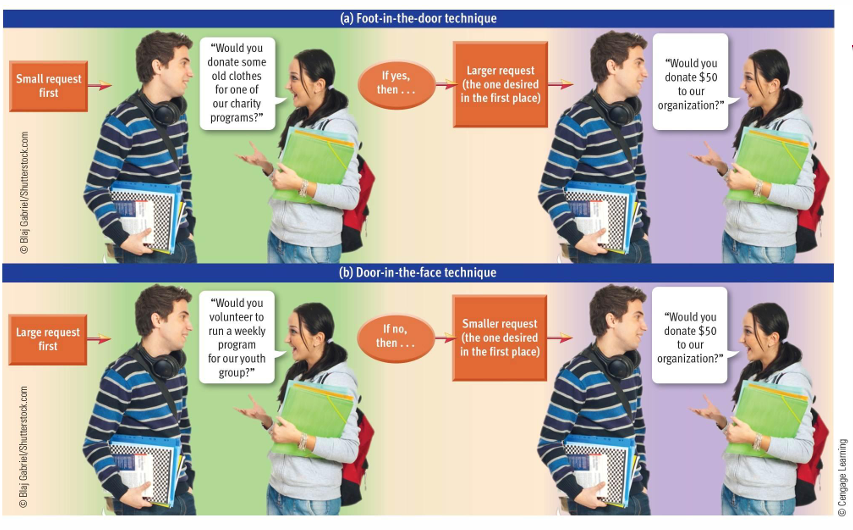
Compliance Techniques (one more)
4. Lowballing - persuader gets you to commit to some action and then - before you actually perform the behaviour - they increase the “cost” of that same behaviour.
• Example - Used car costs only $8000. You agree.
• Salesperson just has to go check with their manager.
• Oops! It’s too low.
• BUT only $400 more and its yours.
Compliance Tactics: The scarcity principle
People believe that if something is scarce, it must be good, and they are more likely to buy it.
This can be exploited by ads claiming:
• “Limited supply available”
• “For a limited time only”
• Order “while they last”
• “Time is running out
Ultimatum Game
Most people make offers of splitting the cash somewhere between 40% and 50%.
Generally speaking, if an offer is made below about 30% it will be rejected by the other person more often than not.
Why?
Decision Making, Emotions, and the Brain
Ultimatum Game
Sanfey, Rilling, Aronson, Nystrom, and Cohen (2003) found that unfair offers were followed by activations in the insula, and the dorsolateral prefrontal cortex. The insula has been predominantly implicated in response to negative emotional states such as anger and disgust